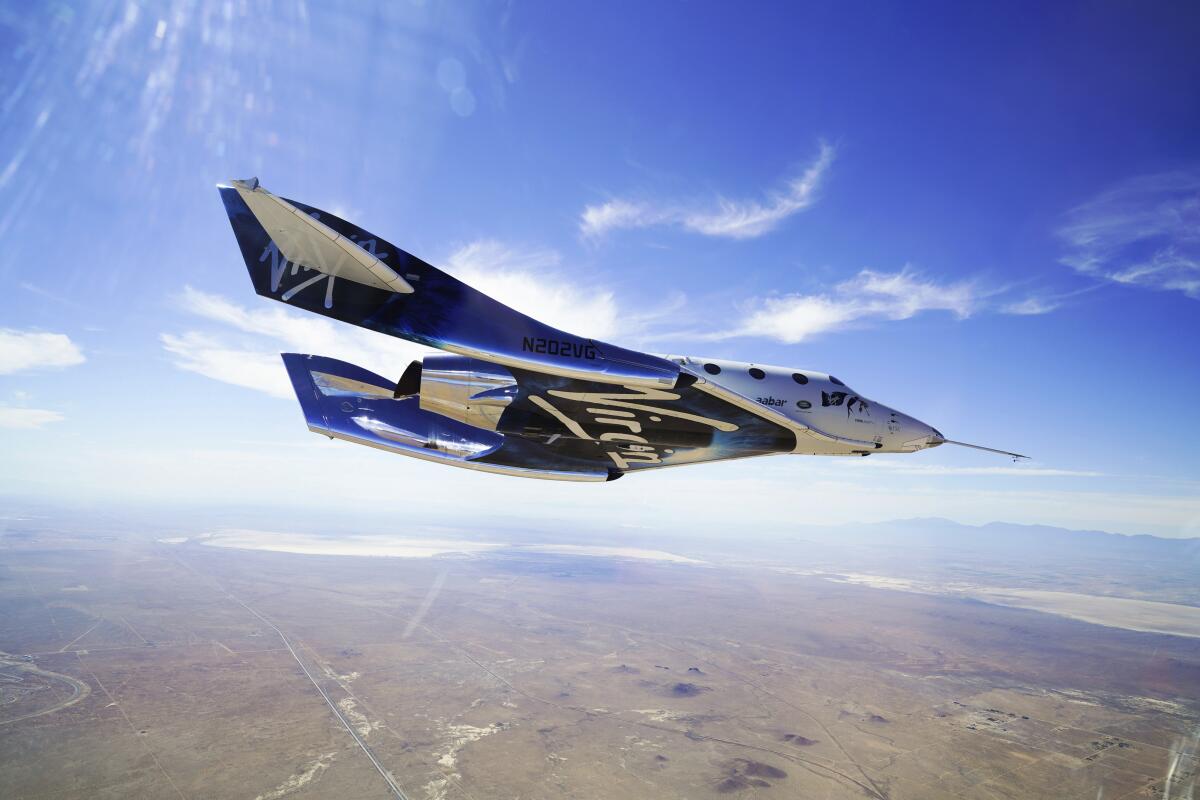Richard Branson’s Virgin Galactic lays off 185 employees, 18% of workforce. Nearly 80 worked in Mojave

- Share via
Richard Branson‘s Virgin Galactic will lay off 185 employees, or about 18% of the company, as the space tourism firm attempts to conserve cash, ride out the skittish capital markets and focus resources on a new line of spacecraft.
The company also will pause its spaceflights in mid-2024 to focus funding and resources on two new spacecraft.
For the record:
12:14 p.m. Nov. 9, 2023An earlier version of this article said the Virgin Galactic layoffs would be largely completed by early next year. Affected employees were laid off this week and their severance and benefits will continue into early next year.
Affected employees were laid off this week, although their severance and benefits will continue into early next year. The layoffs will reduce the company’s employee count to 840 full-time workers, Virgin Galactic executives said Wednesday. The Tustin-based firm said it expects to pay a total of $5 million in severance, benefits and other termination costs.
Virgin Galactic executives said Wednesday that the layoffs would curtail operations related to the company’s current spacecraft, the VSS Unity. That space plane’s operations are near Truth or Consequences, N.M., where the craft launches from, and it receives support from the propulsion team in Mojave.
Among those laid off were about 78 people who worked at the Mojave operation, according to a notice dated Wednesday and filed with the California Employment Development Department, per the Worker Adjustment and Retraining Notification Act.
Affected jobs included engineers, technicians, managers in charge of facilities and quality and some supervisor roles.
The company has a substantial presence in California, with its 61,000-square-foot Orange County headquarters, which serves as the company’s design and engineering center, and manufacturing operations in Mojave, where it also performs test flights.
Chief Executive Michael Colglazier described the layoffs in a statement as a “tough moment” but necessary for Virgin Galactic’s success.
“By taking these actions now, we ensure Virgin Galactic continues to have access to the resources needed to reach positive cash flow and to deliver on our mission bringing the wonder of space to our existing customer base and the generations of customers who will follow,” he said during the Wednesday earnings call.
After years of hype, Richard Branson’s Virgin Galactic started commercial service Thursday with its first flight for paying customers — Italian researchers who conducted experiments.
Virgin Galactic flew its first commercial flight at the end of June and has since flown four additional paying missions, ferrying a mix of wealthy space tourists and researchers. Company founder Branson took his own flight to space in 2021, beating rival Jeff Bezos, who owns space tourism and rocket firm Blue Origin.
But operating the company’s current space plane, VSS Unity, is expensive, and it takes time to turn the craft around and ready it for its next flight, minimizing the number of times it can launch regularly. That’s why Virgin Galactic is going all-in on its next-generation spacecraft, which it calls its Delta-class spaceships.
These space planes, which are still in development, are being designed to fly eight times a month, versus the once-a-month cadence for the company’s VSS Unity craft. The Delta-class ships will also have more seats than their predecessor and are expected to bring in monthly revenue of $21.6 million to $28.8 million per ship, once flights are operational, Virgin Galactic officials said Wednesday. Flight tests for those spacecraft are expected in 2025.
But continuing development of the Delta-class ships and funding the existing VSS Unity flights at the same time has proved expensive.
The company reported revenue of $1.7 million for the three-month period ending in September, up from $767,000 a year ago. The company also reported a net loss of $104.6 million, compared with $145.5 million a year earlier, an improvement Virgin Galactic attributed to “lower operating expenses and an increase in interest income.”
To fund both projects, the company has relied on fundraising in the capital markets, but with rising interest rates and global unrest, investors have become increasingly wary of longer-term endeavors that do not quickly turn a profit.
That’s bad news for Virgin Galactic, which needs time to ensure the safety of its vehicles and passengers and to build a track record of successful flights, said Laura Forczyk, executive director of space consulting firm Astralytical.
“Virgin Galactic really does need to take their time to ramp up operations,” she said. “There are very few investors that would be willing to have that patience.”
The company has cash and assets that can be quickly converted to cash totaling $1.1 billion, a sum executives said would be sufficient to get the first two Delta-class ships developed and into service and also allow the company to reach positive cash flow in 2026.
A seat aboard Virgin Galactic’s space plane now costs $450,000, up from the initial price of $200,000 that early enthusiasts paid. Research flights bring an even heftier fee, at $600,000 a seat. As of December, the company had a backlog of about 800 aspiring passengers and collected about $103 million from them in deposits and membership fees, according to its annual report filed in February with the Securities and Exchange Commission.
Virgin Galactic isn’t alone in its struggles with the financial markets.
Earlier this year, its sister company, Virgin Orbit, closed after the satellite launch firm failed to raise enough funds to offset its spending. Small-satellite launch firm Astra is also in dire financial straits and defaulted on a loan, though it received a temporary reprieve Monday with interim financing secured through the end of next week.
The commonality between all three companies? All went public via a special purpose acquisition company, or SPAC.
“The pressures of raising money for stakeholders and being so public about their finances, and the lack of investor environment right now contributes to the fact that companies have been doing mass layoffs and some companies might go under,” Forczyk said.
More to Read
Inside the business of entertainment
The Wide Shot brings you news, analysis and insights on everything from streaming wars to production — and what it all means for the future.
You may occasionally receive promotional content from the Los Angeles Times.












